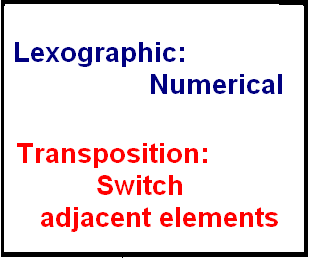Ordering
There are two different ways of ordering the different permutations generated by a number of objects: Lexographic and Transposition
In lexicographic order, the permutations are listed in numeric order: 12...n is first and n...21 is last. Here are the permutations of {1,2,3} listed in lexicographic order: 123, 132, 213, 231, 312, 321.
In transposition order, the ordering is a bit more complicated. Each successive permutation differ only by the transposition of two adjacent elements. You do not need to understand transposition order, but here is an example for {1,2,3}. Note: There are two posibile orderings for this. One is the reverse of the other.
123, 132, 312, 321, 231, 213
